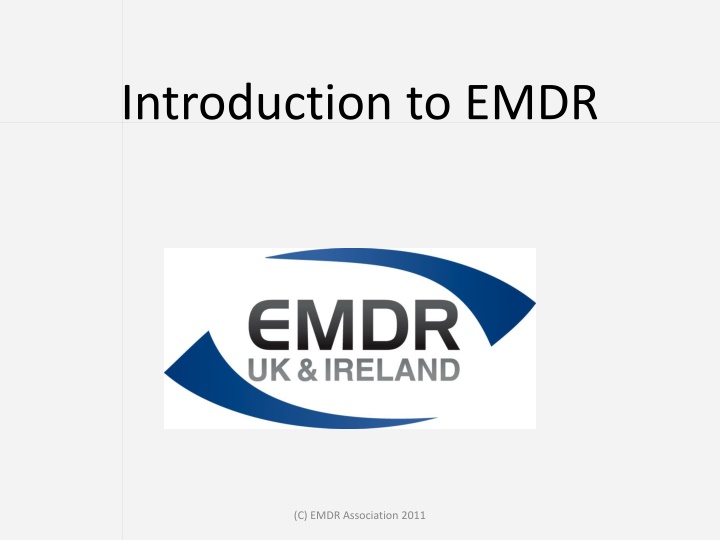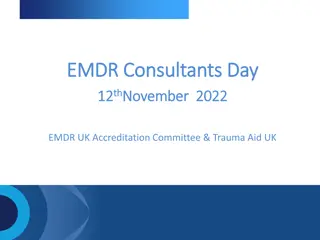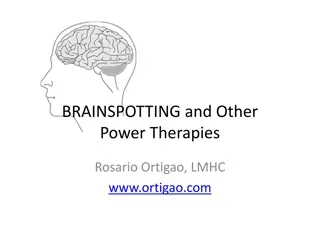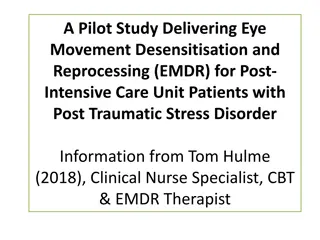Introduction to EMDR
EMDR therapy, developed by Francine Shapiro, is an evidence-based approach aimed at addressing past experiences and current triggers, focusing on alleviating symptoms, distress, and improving self-view. It utilizes Adaptive Information Processing and Bilateral Stimulation in an eight-phase process for comprehensive client treatment towards psychological health.
Download Presentation

Please find below an Image/Link to download the presentation.
The content on the website is provided AS IS for your information and personal use only. It may not be sold, licensed, or shared on other websites without obtaining consent from the author.If you encounter any issues during the download, it is possible that the publisher has removed the file from their server.
You are allowed to download the files provided on this website for personal or commercial use, subject to the condition that they are used lawfully. All files are the property of their respective owners.
The content on the website is provided AS IS for your information and personal use only. It may not be sold, licensed, or shared on other websites without obtaining consent from the author.
E N D
Presentation Transcript
Introduction to EMDR (C) EMDR Association 2011
Eye Movement Desensitisation and Reprocessing It is twenty years since Francine Shapiro formulated and introduced EMDR to the mental health community According to Shapiro (2007) EMDR is an integrative, client-centred psychotherapy approach that emphasises the brain s information processing system and memories of disturbing experiences as the bases of those pathologies not caused by organic deficit or insult. (C) EMDR Association 2011
EMDR EMDR addresses the experiences that contribute to clinical conditions and those needed to bring the client to a robust state of psychological health (Shapiro, 2007) EMDR is an evidence-based psychotherapy for Post- Traumatic Stress Disorder (PTSD) Successful outcomes and positive research are also well- documented in the literature for EMDR treatment of other trauma-related mental health disorders and somatic symptoms (C) EMDR Association 2011
What is EMDR? EMDR is based upon a model know as Adaptive Information Processing (AIP) EMDR is an eight-phase, three-pronged process which facilitates the resumption of normal information processing and integration. (C) EMDR Association 2011
Aim of EMDR for clients EMDR treatment aims to achieve comprehensive treatment: Safely Effectively Efficiently Whilst maintaining client stability (C) EMDR Association 2011
Aim of EMDR for clients EMDR targets past experiences, current triggers, and future potential challenges, in working towards: Alleviating presenting symptoms Decreasing or eliminating distress from the disturbing memory Improving view of the self Relief from bodily disturbance Resolution of present and future anticipated triggers. (C) EMDR Association 2011
The EMDR Approach - Overview EMDR is most known for its use of Bilateral Stimulation (BLS) yet this is just one component of EMDR therapy EMDR is a distinct eight stage, integrative, psychological treatment that combines aspects of other psychological orientations (C) EMDR Association 2011
The EMDR Approach Overview Different diagnoses require different, sometimes customised, EMDR procedures and scripted protocols However all scripted EMDR protocols incorporate the three pronged elements of PAST, PRESENT & FUTURE (C) EMDR Association 2011
The EMDR Approach Overview EMDR is utilised to address the experiences that contribute to clinical problems and health issues EMDR is a psychotherapy approach that is distinct from Psychodynamic, CBT, & Humanistic modalities Memory networks are viewed as the underlying basis of pathology and mental health (C) EMDR Association 2011
Adaptive Information Processing All humans have a physiologically-based information processing system Digests or metabolises information so that it can be used in a healthy life-enhancing manner Natural tendency to move towards mental health Psychological self-healing is similar to other physiological processes (C) EMDR Association 2011
Adaptive Information Processing Trauma causes imbalance in the nervous system thus creating blocked or incomplete information processing This dysfunctional information is then stored in its unprocessed state Identifying the hotspots of unprocessed events is central to EMDR treatment (C) EMDR Association 2011
The Primary Goals of EMDR 1. To release the individual from dysfunctional ties of the past so that Adaptive Responses can be made in the present (C) EMDR Association 2011
The Primary Goals of EMDR 2. To facilitate a distinction between remembering the experience rather than re-experiencing it (C) EMDR Association 2011
The Primary Goals of EMDR 3. To achieve a position where remembering is NOT emotionally disturbing (C) EMDR Association 2011
Explanation of EMDR "Old disturbing memories can be stored in the brain in isolation; they get locked into the nervous system with the original images, sounds, thoughts and feelings involved Shapiro, F. (2001). Eye Movement Desensitization and Reprocessing, 2nd edition, N.Y.: The Guilford Press. (C) EMDR Association 2011
Explanation of EMDR The old distressing material just keeps getting triggered over and over again. This prevents learning/healing from taking place. In another part of your brain, you already have most of the information you need to resolve this problem; the two just cannot connect Shapiro, F. (2001). Eye Movement Desensitization and Reprocessing, 2nd edition, N.Y.: The Guilford Press. (C) EMDR Association 2011
Explanation of EMDR Once EMDR starts, a linking takes place. New information can come to mind and resolve the old problems. This may be what happens spontaneously in REM or dream sleep when eye movements help to process unconscious material. Shapiro, F. (2001). Eye Movement Desensitization and Reprocessing, 2nd edition, N.Y.: The Guilford Press. (C) EMDR Association 2011
For More Information EMDR Association UK & Ireland PO Box 3356 Swindon, SN2 9EE United Kingdom Email: info@emdrassociation.org.uk www.emdrassociation.org.uk (C) EMDR Association 2011












